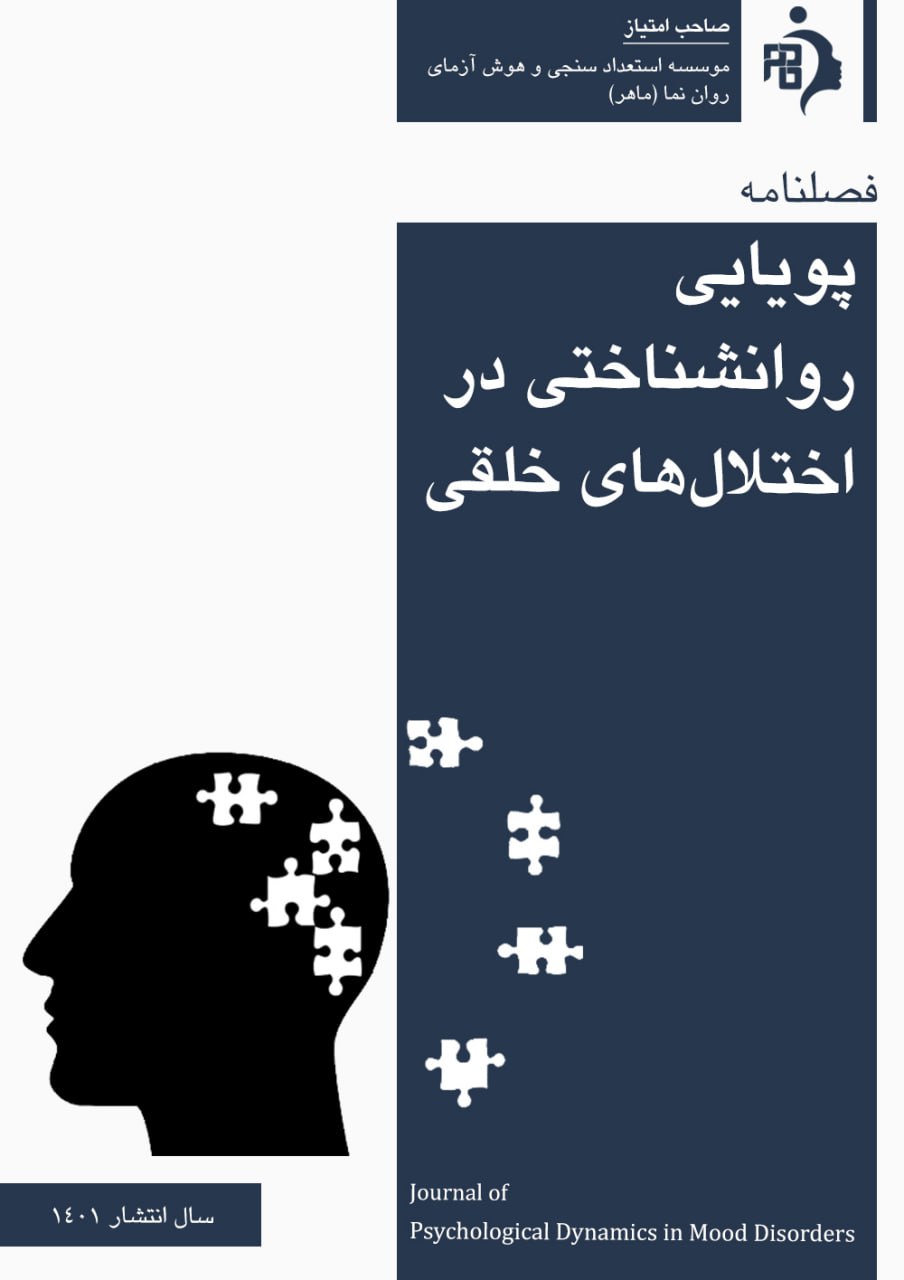Diagnostic Validity of the "Shedler-Westen Assessment Procedure" in a Non-Clinical Sample of the Iranian Oil Industry
Keywords:
Diagnostic Validity, Shedler-Westen Assessment Procedure, Personality Disorders, Non-ClinicalAbstract
Background and Objective: Examining the diagnostic validity of various tools for identifying people with personality disorders is of great importance. As a result, the aim of this study was determine the diagnostic validity of the Shedler-Westen assessment procedure in a non-clinical sample of the Iranian oil industry.
Methods and Materials: This research in terms of purpose was applied and in terms of implementation method was quantitative. The research population was employees of the oil industry applying for managerial positions in 2023 year, which number of people of them were selected as a sample with using the purposeful sampling method. Data were collected with using the Shedler-Westen assessment procedure (SWAP-200) and for determine the diagnostic validity were use, three methods of confidence interval, sensitivity coefficient and clarity coefficient in SPSS software.
Findings: The findings showed that all 12 scales of the Shedler-Westen assessment procedure, including paranoid, schizoid, schizotypal, antisocial, borderline, histrionic, narcissistic, avoidant, dependent, obsessive, depressive, and passive-aggressive had adequate diagnostic validity due to a confidence interval greater than 2 standard deviations. Also, the 9 scales of paranoid, schizoid, antisocial, histrionic, narcissistic, avoidant, dependent, obsessive, and passive-aggressive had appropriate diagnostic validity due to their sensitivity coefficient and clarity coefficient higher than 0.90 and 0.70, respectively, but the schizotypal scale had inadequate diagnostic validity due to a sensitivity coefficient of 0.21 and a clarity coefficient of 0.80, the borderline scale had inadequate diagnostic validity due to a sensitivity coefficient of 0.35 and a clarity coefficient of 0.70, and the depressive scale had inadequate diagnostic validity due to a clarity coefficient of 0.57 and a sensitivity coefficient of 0.65, respectively.
Conclusion: According to the results of this study, specialists and therapists of personality disorders can use the Shedler-Westen assessment procedure as a tool with appropriate diagnostic validity.
Downloads
References
Alibakhshiyan, S., Sarafraz, M. R., Belyad, M. R., Kamkari, K., & Hajiheydari, M. (2024). Concurrent validity of "Shedler-Westen assessment method" and "fourth edition of Millon’s clinical multiaxial inventory" in the non-clinical sample of Iran's oil industry. Sociology of Education. 10(2), 254-263. https://doi.org/10.22034/ijes.2024.2043881.1640
Bradley, R., Hilsenroth, M., Guarnaccia, C., & Westen, D. (2007). Relationship between clinician assessment and self-assessment of personality disorders using the SWAP-200 and PAI. Psychological Assessment, 19(2), 225-229. https://doi.org/10.1037/1040-3590.19.2.225
Cao, Y., Yan, B., & Teng, Y. (2023). The impact of green human resource management on hospitality employees’ quitting intention: A dual perspective study. Journal of Hospitality and Tourism Management, 57, 270-283. https://doi.org/10.1016/j.jhtm.2023.10.012
DeFife, J. A., Malone, J. C., DiLallo, J., & Westen, D. (2013). Assessing adolescent personality disorders with the Shedler–Westen assessment procedure for adolescents. Clinical Psychology: Science and Practice, 20(4), 393-407. https://doi.org/10.1111/cpsp.12049
Garner, A. R., Blocher, N., Tierney, D., Baumgardner, M., Watson, A., Romero, G., & et al. (2022). Applying the DSM-5 alternative model of personality disorders and the Shedler-Westen assessment procedure to the classic case of “Madeline G.”: Novice and expert rater convergences and divergence. Frontiers in Psychology, 13(794616), 1-8. https://doi.org/10.3389/fpsyg.2022.794616
Harrison, S., Grover, S., & Furnham, A. (2018). The perception of sub-clinical personality disorders by employers, employees and co-workers. Psychiatry Research, 270, 1082-1091. https://doi.org/10.1016/j.psychres.2018.05.036
Hein, K. E., Glass, I. V., Frankenburg, F. R., Fitzmaurice, G. M., & Zanarini, M. C. (2025). Emptiness in patients with borderline personality disorder: Severity and predictors of outcome over 24 years of prospective follow-up. Journal of Affective Disorders, 372, 234-240. https://doi.org/10.1016/j.jad.2024.11.075
Kashanaki, H., Pournaghash, S. S., Ghorbani, N., & Bahrami Ehsan, H. (2021). Study of the effectiveness of mindful sensorimotor interventions in the treatment of abnormal personality patterns leading to depression and anxiety: a mixed-method study. Journal of Psychological Sciences, 20(106), 1699-1716. http://dx.doi.org/10.52547/JPS.20.106.1699
Lehmann, M. E., & Hilsenroth, M. J. (2011). Evaluating psychological insight in a clinical sample using the Shedler-Westen assessment procedure. The Journal of Nervous and Mental Disease, 199(5), 354-359. https://doi.org/10.1097/nmd.0b013e3182175138
Marin-Avallen, L., McGauley, G., Campbell, C., & Fonagy, P. (2005). Using the SWAP-
in a personality-disordered forensic population; is it valid, reliable and useful? Journal of
Criminal Behavior and Mental Health, 15(1), 28-45. https://doi.org/10.1002/cbm.35
Oasi, O., Buonarrivo, L., Codazzi, A., Passalacqua, M., Ricci, G. M. R., Straccamore, F., & Bezzi, R. (2017). Assessing personality change with Blatt's anaclitic and introjective configurations and Shedler-Westen Assessment Procedure profiles: two case studies in psychodynamic treatment. Research in Psychotherapy: Psychopathology, Process and Outcome, 20(1), 63-80. https://doi.org/10.4081/ripppo.2017.231
Piwowar-Sulej, K., Blstakova, J., Lizbetinova, L., & Zagorsek, B. (2024). The impact of digitalization on employees' future competencies: has human resource development a conditional role here? Journal of Organizational Change Management, 37(8), 36-52. https://doi.org/10.1108/JOCM-10-2023-0426
Post, R. M., Leverich, G. S., McElroy, S. L., Kupka, R., Suppes, T., Altshuler, L. L., & et al. (2022). Are personality disorders in bipolar patients more frequent in the US than Europe? European Neuropsychopharmacology, 58, 47-54. https://doi.org/10.1016/j.euroneuro.2022.02.007
Rambelji, K., Vander Heijden, P. T., & Egger, J. I. M. (2024). Prototypes and dimensions: Relations between the Shedler-Westen assessment procedure (SWAP-200) and the personality psychopathology five (PSY-5) maladaptive personality traits. International Journal of Psychology and Psychological Therapy, 24(3), 373-383. https://www.ijpsy.com/volumen24/num3/671.html
Shedler, J., & Westen, D. (2007). The Shedler–Westen assessment procedure (SWAP): Making personality diagnosis clinically meaningful. Journal of Personality Assessment, 89(1), 41-55. https://doi.org/10.1080/00223890701357092
Smits, P. G., Foek-Rambelje, K. L. S., Rinne, T., Vander Heijden, P. T., Kempes, M. M., & Egger, J. I. M. (2021). Personality assessment with the Shedler-Westen assessment procedure 200 in a forensic sample: Criterion validity and contribution to structured forensic clinical judgement. The Journal of Forensic Psychiatry & Psychology, 32(5), 736-751. https://doi.org/10.1080/14789949.2021.1903066
Welch, J. E., Luo, W., Ambroise, K. J., Choi, Y. N., Jones, K. G., De Rouen, A., & Fineberg, S. K. (2024). Tell Me about yourself: Analyzing self-referential language use in borderline personality disorder. Journal of Psychiatric Research, 180, 428-438. https://doi.org/10.1016/j.jpsychires.2024.11.011
Westen, D., Waller, N. G., Shedler, J., & Blagov, P. S. (2014). Dimensions of personality and personality pathology: Factor structure of the Shedler-Westen assessment procedure-II (SWAP-II). Journal of Personality Disorders, 28(2), 281-318. https://doi.org/10.1521/pedi_2012_26_059
Young, M. (2024). Advances in management of personality disorders in a residential setting. Advances in Psychiatry and Behavioral Health, 4(1), 147-155. https://doi.org/10.1016/j.ypsc.2024.05.010



























